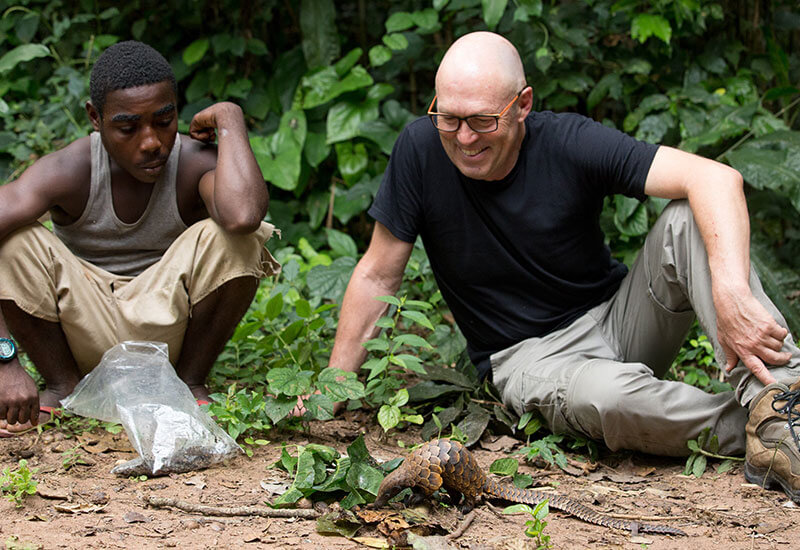A ground-breaking new documentary, Eye of the Pangolin, was released on 17 May 2019, on Endangered Species Day.
The film tells the story of two award-winning South African filmmakers who venture out across the African continent to capture all four species of the extremely rare and elusive African pangolin on film.
Watch the Eye of the Pangolin documentary for FREE on YouTube.
Pangolin Wildlife Documentary
The project began in 2017 when South African filmmaker Johan Vermeulen approached award-winning Blood Lions film director, Bruce Young to create the first-ever wildlife documentary about the world’s most trafficked mammal – the pangolin.
The film crew embarked on a mission to capture all four African pangolins on film for the very first time. The documentary aims to raise awareness about the pangolin species, in hopes that people will come to know and appreciate these gentle and harmless creatures.
The crew travelled throughout the African continent in search of the four species of African Pangolin:
- The White-bellied Pangolin in Ghana
- The Black-bellied Pangolin in the Central African Republic,
- The Temminck’s Ground Pangolin in various locations across Southern Africa, and
- The most elusive of them all, the Giant Ground Pangolin in Gabon.
As well as raising awareness of these shy and unique creatures, the Eye of the Pangolin also sheds light on the number of organizations aiming to protect and save the lives of these endangered animals.
The Most Trafficked Mammal on the Planet
The pangolin is the most trafficked mammal on Earth.
Due to an insatiable market in Asia, the pangolin species is being pushed to the brink of extinction. Hunted and sold in on the black market, pangolins are in high demand.
In some countries, pangolin meat is considered a delicacy. In the Traditional Chinese Medicine trade, pangolin scales are believed to have ‘medicinal purposes.’ Despite there being no scientific proof of this, the animal is mercilessly hunted and trafficked.
This shy animal has become part of the illegal wildlife trafficking trade that has sadly left them on the brink of extinction.
Although the film only touches on the topic of pangolin poaching, the documentary aims to focus on the pangolins themselves. The film also showcases the tireless work of the researchers, vets, veterinary nurses, ecologists, pangolin monitors and other stakeholders actively working to help save pangolins from the illegal wildlife trade.
Raising Awareness for the Illegal Pangolin Trade
Eye of the Pangolin aims to enchant viewers by capturing the natural beauty and gentle nature of the pangolin.
The film hopes to raise enough awareness about the species that more people will come to care about the animal and help put an end to the horrific trade.
The documentary questions man’s relationship with the wildlife of this planet and asks that we reassess the impact we have on animals that are becoming endangered and on the brink of extinction.
The film poses the question, “If we lose the pangolin, do we lose a part of ourselves? What will it mean to live in a world with fewer and fewer wild creatures and animals we share this planet with?”
Our actions as a species today have serious effects on what the world will look like tomorrow.
Where You Can Watch the Eye of the Pangolin Documentary
The Eye of the Pangolin is free to watch as an open source film on various online platforms.
The film will be shown at wildlife and conservation film festivals and will be and driven through education, conservation and tourism networks. The goal of the documentary is for millions of people around the world to learn about pangolins.
Watch Eye of the Pangolin now, and share it with your friends, family, colleagues and social network.
We hope that you enjoyed reading about the Eye of the Pangolin documentary. If you want to get involved, visit the Pangolin Africa website and follow their social pages on Facebook, Twitter, Instagram and YouTube.
If you’re interested in learning more about these gorgeous creatures, read our collection of pangolin facts.
Featured image captured by Eye of the Pangolin filmmaker Johan Vermeulen.



Though the documentary focuses less on the illegal trafficking of pangolins, and more on the animals in their natural habitat, the aim of the documentary is to inspire viewers around the world to call for action in ending illegal trafficking and protecting these unique creatures.